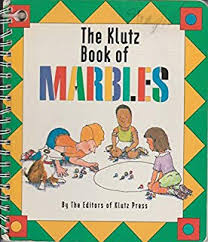Marbles
Listen to the Recess! Clip
| Author | John Cech |
| Air Date | 4/28/2004 |

Marbles Transcript
Brief sound clip
Now, if you’re a real mibster, you know what that sound is, and you can probably tell if you’re hearing a bumboozer with three or four Mica snowflakes, a root-beer float, a couple of cat’s eyes, and a commoney or two, or if it’s an outlawed steeley with some aggies, clearies, and a sprinkle of pee-wees, mixed in with a slag, a Lutz, and a Kabola.
We’re talking marbles, and I’ve been studying up on them again in a terrific little volume called The Klutz Book of Marbles that comes complete with a sack of swell swirlies and detailed instructions for your youngsters (or you) about how to reinvigorate the game in your neighborhood. Marbles has one of the best vocabularies of any of the traditional games of childhood. And it is surely one of the oldest. Our Pleistocene ancestors wiled away many centuries, waiting for the glaciers to receede, by rolling or pitching balls of dried-out mud at a target on the floor of the cave. We do know that the ancient Egyptians and Romans played one of the many versions of the game with orbs made from a variety of materials, including fired clay. Marbles came into their own (and got their name) from the alabaster marbles that some fancy master-players, or mibsters, started using in the 1800s. But the real technological break-through occurred in Germany in the 1840s, when a glassblower figured out how to cut long rods of red-hot glass into small pieces and then roll them into spheres.
But back to that vocabulary. As you may be starting to remember, the actual game of marbles — whether it’s called Ringer or Potsies or Skelly or Puggy or Bomber or Dropsies — always begins with another game, called lagging, in which you draw two lines anywhere from five to ten feet apart. Then, without crossing the first line, the lag line, you shoot your marble at the other. The closest to the second line starts the game. Getting your marble right up to the line without going over is, of course, “lagging behind.” But there is another protocol — in shooting, you have to keep your hand flat on the ground, and “knuckle down” — no “hunching” or “fudging” and only use your thumb to propel the marble at its target. And maybe the most important thing of all to know up front is whether you’re playing “friendlies” or “keepsies.”
Today’s program featured the following: